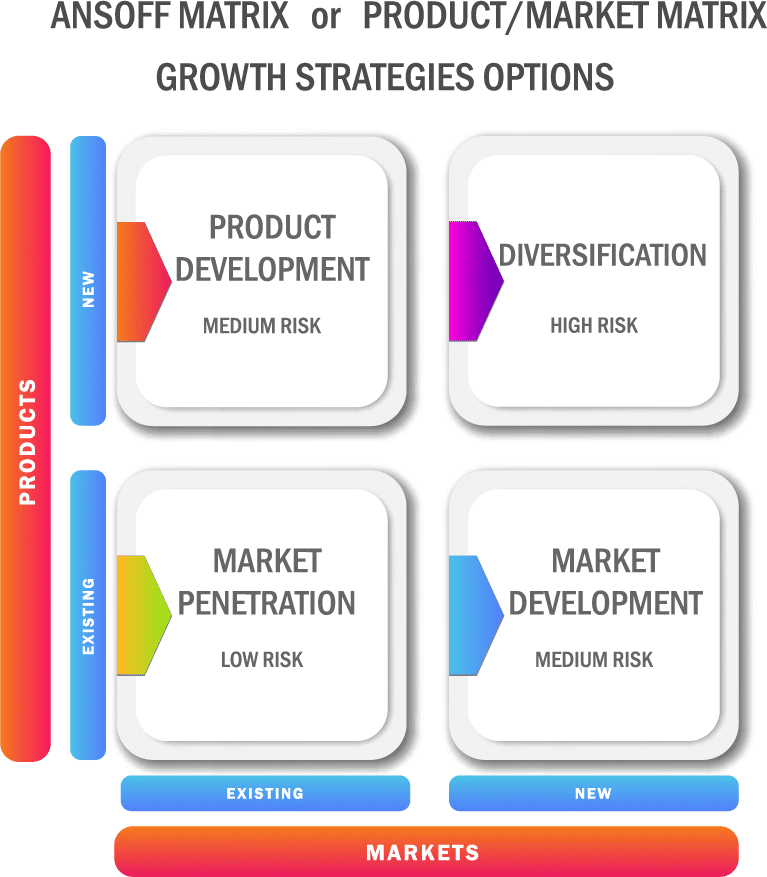When it comes to marketing, there are a lot of different tools and techniques you can use to design an effective marketing strategy. Some of them you may have heard of before, like the SWOT analysis, but others are less well known – though no less valuable. Just one of the tools we like to use when we’re first building a marketing strategy for a new client is called the Ansoff Matrix. It’s a helpful tool when a business has some marketing efforts already in place, but is looking for a way to grow its business to the next level.
What is the Ansoff Matrix?

The Ansoff Matrix is essentially a strategic planning tool for businesses. Originally designed by Russian mathematician and business manager Igor Ansoff in 1957, it gives owners and managing staff a framework to draw up new growth strategies. In his paper describing the theory, Ansoff described four ‘growth alternatives’ for growing an organisation in new or existing markets with new or existing products, each of which poses a different level of risk and reward for the business. This breaks the matrix down into the following 4 strategic options:
Market penetration
Increasing the sales of existing products in your current markets. This could be done by decreasing prices, increasing your advertising efforts, or even buying out a competitor in the space.
Market development
Focuses on entering a completely new market with your existing product range. This means researching a new customer segment, refining which products to supply into it, and potentially investigating export if your new segment is in a foreign country.
Product development
Creating new products to meet the needs of your existing customer base. This usually means investing in R&D for new products, forming strategic partnerships, or acquiring a competitor and using their resources to help create a new product.
Diversification
Often the riskiest approach, focused on entering a new market by introducing a new range of products. This can be either looking for synergies between new markets or products and what you do now or starting up a completely different line or entering a completely different market.
The matrix is most often displayed as a grid of the 4 strategies, that business owners can arrange for their new and existing products or markets, and in order of risk. Generally speaking, market penetration is considered the least risky strategy, while diversification has the highest risk profile.
The aim of the matrix is to help decision-makers identify possible actions associated with each of the four growth strategies, and order them from lowest to highest. By doing this, key decision-makers have a clear view of what their options are, and can choose the option most suited to their risk appetite.
How Do You Use the Ansoff Matrix?
While that might initially sound complicated, actually using the Ansoff Matrix is surprisingly simple. There are a number of templates available online for the matrix, or you can create your own if you prefer. You then bring together all relevant parties and analyse your options in each of the sections. This is usually a lengthy discussion, but it can be incredibly fruitful for the general growth of the business as well. For example, when looking at the market development sector, you might look at using different sales channels, targeting a different geographical area, or widening your marketing segment to include a different group of people. When you’re looking at market penetration it’s all about trying to sell more of the same things to the same market, so this might include developing a new marketing strategy, introducing a loyalty scheme, or increasing the activity of your sales staff. Work through each of the sections until you have a good number of options in each one.
Next, you need to look at risk management. You can do this in a few different ways. You can either go with your gut about what will be most risky for your business, or you can conduct a risk analysis to get a better understanding of the risks vs benefits for each strategy. We strongly recommend the latter! Once you understand the risks, it’s time to choose the best option for you, based on the information you have. We also recommend creating a contingency plan around the option or options you choose, especially if you’re opting for a riskier strategy, so there is a safety net there if you need it.
The Benefits of the Ansoff Matrix
When you do start to use the matrix, you will quickly find it has a number of benefits for your business. For example, using the matrix can help your business identify new growth strategies while avoiding key risks that may otherwise have gone unnoticed. The Matrix has been used by many businesses to unlock the ‘easy wins’ to growth by laying out the growth options within their existing market and product, before widening out to the riskier strategies. It can also help decisions makers avoid misunderstandings around strategy and risk, and means business owners can select the appropriate growth strategy for the business. The Ansoff matrix is a key tool in developing new marketing strategies, and many businesses will choose two options from the matrix to reach different markets and improve their chances of growth.
Ansoff’s Matrix In Action
Because it often takes place behind closed doors, seeing Ansoff’s Matrix in action can be a difficult thing. However, it has been applied in many large corporations to grow their business, and there is one company where the effect is very obvious: Coca-Cola. Here is how the matrix can be applied to the Coca-Cola brand:
Market Penetration:
This section is all about promotion, and Coca-Cola runs a lot of those! The most famous promotion of an existing product is their annual Christmas campaign, complete with Coca-Cola train and Santa, which helps boost sales during the festive period. They also run multiple promotions throughout the year for special events or seasons, all designed to boost sales of their core product.
Market Development:
Here, Coca-Cola needed to find a new group of buyers for its existing products. Here is where the sub-types of Coca-Cola come in – Diet, Zero, and Caffeine Free. Diet and Zero are the perfect examples of market development, as they are essentially the same product – Coke with zero sugar and calories. But market research showed that diet coke (which has been around since the 80s) was seen as a more of a ‘feminine’ drink, and so they developed Coke Zero in 2005 – branded with a polar opposite approach to diet coke in order to appeal to men.
Product Development:
This is where we see all the new flavours of coca-cola entering the market, as the company looks for ways to meet customer needs in a different way. Their first experiment was Cherry Coke in 1985, a small change to the original recipe that was met with wild success. The company has since launched a range of other flavours as either permanent or ‘limited edition’ flavours, including lime, lemon and vanilla – and more recently, raspberry, strawberry, ‘energy’ and a range of diet coke ‘mixers’ specifically formulated to work well with spirits.
Diversification:
In this case, Coca-Cola has chosen to pursue two types of diversification – related and unrelated. Their related diversification involved acquiring a competitor in the food and drinks industry in 2007 – Glaceau and their Vitaminwater brand. This allowed them to capitalise on the growing ‘healthy’ side of the beverage market while still retaining their market hold on the sugary drinks side. And for unrelated diversification, they started to produce merchandise with their branding on it, including pens, t-shirts, glasses and even fridges! This created a strong brand attachment in customers and promoted their brand to new markets at the same time.
So you see, there is often much more behind a marketing strategy than meets the eye. Ansoff’s Matrix is just one of the tools marketing agencies like us use to create a robust content marketing strategy that meets the needs of your business and your customers, and implement it much more effectively. Our content marketing strategies are completely tailored to your business, so you can see maximum results. If you would like to know more, just get in touch with the team today.





0 Comments